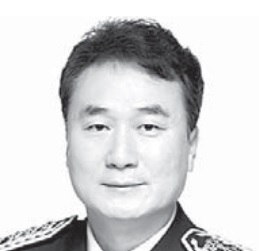The tech-driven era of fire safety 4.0

The author is acting commissioner general of the National Fire Agency.
On Nov. 15, some 100,000 members of ARMY, the fans of the world-famous K-pop band BTS, made their way from all around the world to Busan for a concert. To make sure that everyone could enjoy the momentous occasion in perfect safety, the City of Busan collaborated with a whole host of agencies and departments. Fire service, of course, played a key part, forming an emergency response team with over 230 fire officers and 26 rescue and emergency vehicles deployed around the concert venue. Thanks to such meticulous preparedness supported by our firefighters, the evening was a great success.
In recent weeks and months, Korea’s multidimensional and systematic approach to public safety and disaster response has repeatedly proved its effectiveness. In September, for example, when the typhoon Hinnamnor hit Pohang, our government-wide disaster response system was already in full swing. When the record-breaking downpour grounded even fire vehicles, the Marine Corps’ amphibious vehicles went at once to the rescue of those trapped in flash floods. High-capacity water pump systems, normally used on large-scale fires, were also instrumental in the rescue of two survivors from a flooded underground parking lot.
Such timely and proactive response, involving all public safety organizations from fire service and police to the military, was made possible by the innovative use of cutting-edge equipment.
Take the devasting mountain fire in March which swept across multiple regions. In addition to the high-capacity water pump system, advanced chemical response vehicles and specialist wildfire suppression vehicles were vital in protecting key sites of national importance such as nuclear power stations and Geumgang pine tree colonies. Cutting-edge equipment like these, powered by the latest innovations, enable game-changing upgrades to the field capacity of our firefighters, thus aiding our efforts to minimize damage.
As disasters are fast becoming larger in scale and more complicated in nature, Korea’s fire service is gearing up with innovative technologies and new knowledge for a great transformation into the digital age. The era of ‘Fire Safety 4.0,’ informed by fresh perspectives and novel approaches to public safety, will see the key drivers of the fourth industrial revolution, such as artificial intelligence, big data, and robotics, also transforming our equipment and methods for a future-ready force. State-of-theart equipment like unmanned demolition fire vehicles and firefighting drones will be introduced to field operations, with corresponding improvements to response strategies and systems, so that our firefighters may serve more effectively and more safely.
Prevention is another area which will benefit from such proactive use of technology. Big data analysis on fire, rescue and emergency medical service dispatches will inform efforts to better predict risks in different seasons and regions. In particular, we’re using data analytics to forecast various risks to the most vulnerable groups so that we can take more effective measures to prevent accidents. We’re also sharing public data with other agencies and strengthening collaboration with private sectors partners.
All these firefighting innovations serve one clear purpose: to better protect the safety of our citizens. Korea’s ‘the Era of Fire Safety 4.0’, powered by the latest in science and technology, will be guided by that steadfast sense of mission.
And that mission, as Korea continues to grow as a leading member of the global community, also extends to an increasing number of foreign guests visiting our country. For the safety of all lives on this land, Korea’s fire service will always be ready to serve.










with the Korea JoongAng Daily
To write comments, please log in to one of the accounts.
Standards Board Policy (0/250자)